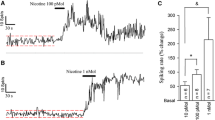Abstract
The activity of neurons of the reticular portion of the substantia nigra before and after the microinjection of haloperidol (25 μg/5 μl) into the head of the caudate nucleus on the ipsilateral side was investigated under chronic experimental conditions in cats, using the extracellular microelectrode pickup technique. A significant (p<0.05) increase, from 34 to 61%, of neurons with the burst type of spontaneous activity was established after the injection of haloperidol. A significant increase in the ratio of the number of excitatory responses to inhibitory responses, from 0.04 to 0.4, was identified among the reactions associated with saccadic eye movements following the microinjection of haloperidol. The number of orienting saccades in response to the visual stimulus decreased against this background from 58 to 37%. The identified changes are regarded as a result of the disinhibition of GABAergic neurons of the reticular portion of the substantia nigra under the influence of the blockade of D2 dopamine receptors of the neostriatum.
Similar content being viewed by others
References
C. A. Altar and M. R. Marien, “Picomolar affinity of125I-SCH23982 for D1 receptors in brain demonstrated with digital substration [sic] autoradiography”,J. Neurosci.,7, No. 1, 213–222 (1987).
M. E. Anderson and F. B. Horak, “Motor effects produced by disruption of basal ganglia output to the thalamus,” in:The Basal Ganglia. Structure and Function, J. S. McKenzie et al. (eds.), New York-London (1984), pp. 355–372.
M. B. Carpenter, “Interconnections between the corpus striatum and brain stem nuclei,” in:The Basal Ganglia. Structure and Function, J. S. McKenzie et al. (eds.), New York-London (1984), pp. 1–68.
E. Chevalier, S. Vacher, J. M. Deniau, and M. Desban, “Disinhibition as a basic process in the expression of striatal function. I. The striatonigral influence of tectospinal/tectodiencephalic neurons”,Brain Res.,334, No. 2, 215–226 (1985).
G. Di Chiara and M. Morelli, “Output pathways mediating basal ganglia function,” in:The Basal Ganglia. Structure and Function, J. S. McKenzie et al. (eds.), New York-London (1984), pp. 443–466.
M. D. Hall, P. Jenner, E. Kelly, and C. D. Marsden, “Differential anatomic localization of [3H]-N-n-propylnorapomorphine and [3H]-spiperone binding sites in the striatum and substantia nigra of the rat”,Brit. J. Pharmacol.,79, No. 3, 599–610 (1985).
O. Hikosaka and R. H. Wurtz, “Visual and oculomotor functions of monkey substantia nigra pars reticulata. IV. Relation of substantia nigra to superior colliculus”,J. Neurophysiol.,49, No. 5, 1285–1301 (1983).
O. Hikosaka and R. H. Wurtz, “Modification of saccadic eye movements by GABA-related substances. II. Effects of muscimol in the monkey substantia nigra pars reticulata,”J. Neurophysiol.,53, No. 1, 292–308 (1985).
H. Jasper and C. Ajmon-Marsan, “A stereotaxic atlas of the diencephalon of the cat,” in:Nat. Res. Council. Can., Ottawa (1954), p. 90.
J. P. Joseph and D. Boussound, “Role of the cat substantia nigra pars reticulata in eye and head movement. I. Neural activity,”Exptl. Brain Res. 57, No. 2, 286–296 (1985).
J. N. Joyce and J. F. Marshall, “Quantitative autoradiography of dopamine D2 sites in rat caudate-putamen: localization to intrinsic neurons and not to neocortical afferents”,Neuroscience,20, No. 3, 773–795 (1987).
J. W. Kebabiana and D. B. Calne, “Multiple receptors for dopamine”,Nature,277, No. 5692, 93–96 (1979).
M. Steriade, G. Oakson, and N. Ropert, “Firing rates and patterns of midbrain reticular neurons during steady and transitional states of the sleep-waking cycle”,Exptl. Brain Res.,48, No. 1, 37–51 (1982).
Additional information
Department of the Physiology of the Cerebral Cortex and Subcortical Structures, A. A. Bogomolets Institute of Physiology, Academy of Sciences of Ukraine, Kiev. Translated from Fiziologicheskii Zhurnal irneni I. M. Sechenova, Vol. 80, No. 1, pp. 17–22, January, 1994.
Rights and permissions
About this article
Cite this article
Voloshin, M.Y., Lukhanina, E.P. & Kolomiets, B.P. Influence of the blockade of D2 dopamine receptors of the cat neostriatum on the baseline activity and saccadic eye movement-associated reactions of neurons of the reticular portion of the substantia nigra. Neurosci Behav Physiol 25, 58–62 (1995). https://doi.org/10.1007/BF02359251
Received:
Issue Date:
DOI: https://doi.org/10.1007/BF02359251



